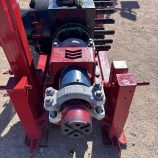AI in Manufacturing: Achieving Precision in Operations

Posted: March 5, 2024
By 2028, the AI market in oil and gas is expected to reach $4.21 billion, with a growth rate of 12.09% annually. AI is transforming the industry by enabling the analysis of large datasets and identifying patterns, leading to advancements such as predictive maintenance to avoid expensive manufacturing breakdowns and optimizing supply chains.
Companies that adopt AI early gain a significant competitive advantage in the market, thanks to the enhanced safety, reduced costs, increased efficiency, quality control, and faster decision-making that come with advancement. Those that delay, on the other hand, risk falling behind in a rapidly progressing technological era.
Here, we’ll look at how the adoption of AI throughout the manufacturing value chain can transform a company’s overall progress. We’ll also explore how Gilmore is utilizing this technology, and the knock-on benefits for all stakeholders in the logistics network.
The Role of AI in Manufacturing for the Oil & Gas Sector
The incorporation of AI in manufacturing is not just an enhancement but a fundamental shift, enabling unparalleled process optimization and predictive maintenance. AI promises to reshape the industry's manufacturing landscape, fostering improved efficiency and reducing costs with:
Predictive Maintenance
AI-driven predictive maintenance is redefining asset management in the oil and gas sector by enhancing reliability and reducing operational risks. Traditional approaches often led to either excessive maintenance or unforeseen equipment failures due to their reactive nature or rigid scheduling. But with AI, companies can leverage large datasets—including historical and real-time operational information—to foresee and prevent potential breakdowns.
AI is shifting the oil & gas sector from reactive to proactive manufacturing strategies—which in turn leads to lower costs, plus improved safety and efficiency.
Enhanced Efficiency and Precision
Using AI to optimize routes on CNC (computer numerical control) machines enhances production efficiency on the manufacturing floor. The algorithms can rapidly analyze design data and material properties to optimize shared component routings, selecting the most effective sequence of operations for each job. This can minimize the wear on tooling and runtimes while improving the quality of the finished product and increasing output.

Additionally, AI can detect changes and inconsistencies within datasets so that continual improvement can be applied to operational processes, in accordance with production constraints. Jobs may be batched, prioritized, and reordered continually. This level of optimization leads to significant reductions in waste and energy consumption, as well as faster production cycle turnaround times.
By integrating AI with system data collections, manufacturers can continue to increase output that would be challenging with traditional monitoring methods, ultimately leading to smarter, more agile manufacturing processes.
Business Process Automation for Back-Office Tasks
Manufacturing involves a multitude of repetitive and time-consuming back-office activities. AI, however, can automate many of these routine back-office tasks, further enhancing efficiency and productivity. For instance, business process automation can streamline invoice processing by quickly and accurately extracting data, verifying it, and updating financial systems, thereby cutting down on manual labor and reducing errors.
Beyond simple task automation, AI extends to complex functions like data integration and analysis. When it comes to supply chain management, AI consolidates information from multiple sources—including suppliers, inventory, and demand forecasts—to refine procurement strategies and ensure proper stock levels.
Demand Forecasting
Traditional demand prediction methods can require an enormous amount of research time and effort when handling the complexities of today's global energy markets. AI is proving to be a valuable tool that can bolster the demand forecasting process. Unbiased, detailed models can detect complex patterns by analyzing extensive historical data, market trends, and geopolitical events, details that may skew prejudiced by human analysts. This leads to more accurate, data-informed decisions.

Additionally, AI's real-time data processing allows for swift responses to market changes, such as adjusting production and logistics during sudden demand spikes caused by extreme weather or geopolitical incidents. Incorporating AI enables oil and gas companies to improve decision-making, optimize resources, cut costs, and increase profitability.
Supply-Chain Management and Compliance
AI improves decision-making by analyzing supplier performance. Companies can pinpoint dependable suppliers, track compliance with quality standards, and foster strong supplier ties. Moreover, AI aids in accurate cost predictions by examining past data and market patterns, assisting firms in budget planning and management to keep projects financially on track.
With improved monitoring, streamlined data analysis, and enhanced risk evaluation, companies can proactively tackle compliance challenges. Adopting AI in one’s manufacturing processes paves the way for a compliant, ethical, and sustainable future for the oil and gas sector.
How AI Has Expedited Process Optimization for Gilmore
At Gilmore, we’ve recognized the advantages of integrating AI in manufacturing and business processes, forming a dedicated team to harness these emerging technologies in the following applications:
Purchasing, Procurement, and In-House Production
We deploy AI to help examine thousands of subcomponents and materials, aiding our procurement team in making cost-effective purchasing decisions. One of the greatest benefits of AI integration in our system is accuracy—for purchasing, planning, scheduling, and delivering. Analyzing large data sets helps us gain clear insights into:
- The most economical batch sizes of items to manufacture in-house, versus purchase
- Optimal work center operation scheduling, based on real outcomes
- Price and delivery term negotiation with vendors, by accurately forecasting annual demand for goods and materials from historical trends and future projections
Production Flow Optimization
We use the analyzed data to develop intuitive dashboards for operational teams, enhancing their productivity and efficiency. This enables us to yield better planning and scheduling to predict and optimize our internal maintenance schedule—along with other constraints—which all leads to increased throughput.
Gilmore Insider Insights: “Gilmore’s parts list is extensive and maintaining that list and adapting it to conform to new standards and needs has been a manual process—until AI. Our Data Analyst developed a program that evaluated every part in Gilmore’s portfolio based on key data and re-categorized it with 98% accuracy, leaving minimal manual work on the remainder.” – David Plakos, Data & Analytics Manager
Improving part data enables the procurement team to categorize needed parts better and, when combined with demand forecasts, negotiate the best possible price and delivery terms possible.
Manufacturing Process Optimization and Improvement
As a proven flow control technology partner, we also employ AI in manufacturing to evaluate and adjust CNC program routes and group like parts to improve and streamline our own component machining processes significantly. This includes optimizing tooling within the CNC equipment so that jobs run more efficiently.
In addition, our product engineers support material selection and production decisions through field and lab performance data analytics. We test which materials best handle pressure, erosion, corrosion, and resist leaking. By analyzing trends and patterns from the data collected, products are designed to exceed offshore industry requirements with an increase in cycle life proven through extreme qualification testing to meet the demand of 5-year service life under normal operating conditions.
Navigating the Future: AI-Driven Excellence in Oil & Gas Manufacturing
By making sense of complex datasets and automating critical decisions, AI serves as the new cornerstone tool for digitalization and operational excellence in manufacturing processes. This allows us to progress as a company, and to better serve our customers.
Integrating manufacturing data analytics into production processes fosters a culture of continuous improvement—crucial for the oil and gas industry to thrive amidst challenges of market volatility and regulatory pressures.
Gilmore has established itself as an industry innovator and leader in superior-quality flow control solutions. Our engineering and manufacturing teams prioritize efficiency, safety, quality, and reliability while striving to offer the best pricing strategy.
Our established flow control distribution network supports global markets, and we welcome the opportunity to partner with operators, contractors, and OEMs in new product developments. Let’s connect.




